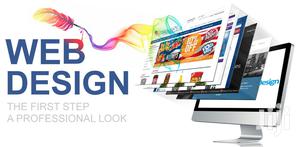Why Your Business Ne...
Why Your Business Needs A Responsive Web Design

Why Your Business Needs A Responsive Web Design
What Is Web Design?
A Website is the final output of a Web design. The Web site sits on a Web server where electronic files are stored. The Web site presents the contents and interactive features or interfaces to the end user in the form of Web pages. How the information requested is displayed to the user is part of the web design process. Additional controls are embedded in order to display more complex media like animations and sound.
Why Should My Business Have A Responsive Web Design?
Business owners are always in the move to ensure that they are able to provide the very best for their targeted customer market, which in turn helps them generate good returns on their investments, as well as keep up with the competition. Having a responsive web design has become the go-to solution for businesses who want a user friendly interface and higher customer retention.
Importance Of A Mobile Friendly Website
A responsive web design allows your users achieve their intended goals as quick and easy as can be. This can only be achieved by ensuring that the important elements of your website and its full functional version can be easily accessed through a smartphone, complete with all the utility you would offer to customers on a laptop or desktop computer.
A happy customer almost guarantees future purchases or collaborations. Google bases their rankings on how useful a page is for the query a user has entered, ease of access for content needed plus the utility of the site – for example, can a user complete the action they would like to? When these questions are answered then one is able to rank well in search engine rankings.
If your site is responsive and ready to service mobile customers, you can take advantage of many tools and helpful apps like the click-to-call button, this enables a web user to make a voice call to your company immediately. Potential customers can also read reviews about your business or even find your business using Google Maps, both keenly relevant to the needs of mobile users.
It is also important to consider branding as one of the ways in which a business builds a relationship of trust with its customers. Customers do not feel confident in a site they cannot easily navigate, in order to create a uniform brand you’ll need a responsive design to produce a consistent web appearance across all devices i.e. mobile, laptop and desktop.
Responsive Web Desing Features
In the recent past web designers created different pages depending on where they would be viewed, a tablet for example has a different screen resolution to a laptop, and so the content would be optimized for viewing on that particular device.
Responsive web designers have created an across the board experience allowing customers to view pages on a smartphone, notebook or PC in exactly the same way. Responsive web designers believe that their clients’ web pages should be accessible to every visitor, giving them an enjoyable experience, irrespective of the device they are using in an ever changing online marketplace.
There are three Key Features of a responsive web design which include:-
- CSS (Cascading Style Sheet)
A responsive design involves the use of CSS or a dynamic resizing function to create flexible images, videos and other content. Text can flow relatively easily as the containing area resizes, but in order to spread this across more complex segments, web designers need to use different techniques. Dynamic resizing gives a web designer greater control over how a page behaves and enables them to add or remove components as needed.
- Media queries
These are filters added on to the CSS or Cascading Style Sheets, affecting the look and feel of any individual page. CSS is a highly useful tool for web designers, but by tagging on a media queries adaption, the process of resizing, rendering and orienting a page becomes far easier.
- Flexible layout
This is based on a grid formation, ideal for formatting margins, positioning the key elements of a page and getting the spacing just right. This means a designer is not limited to a certain number of columns, they can choose as many or as few as is appropriate for the page. A flexible layout also removes the need to work out the layouts and text size based on pixels.
Based on the above customers can enjoy the feeling of familiarity, regardless of what device they happen to be using, or will be using in the future.
Customers are driven away by high wait times and pages that take too long to appear, external factors like lack of Wi-Fi or 4G can also affect wait times, the importance of speed for business sites cannot be underestimated.
Design matters because it can have a huge impact on the number of new visitors to your pages, these are people who have reached you through typing in a specific search criteria and decided to click on the link to your site.
If the response to your website does not conform to the above mentioned criteria then visitors of your website are far less likely to view your entire organization or stay long on your website and they are most likely to share their experience with friends.
Research shows that people would never recommend a company that had poorly designed pages, strengthening the case for a consistent web strategy that performs the way your customers want it to – wherever they happen to be.